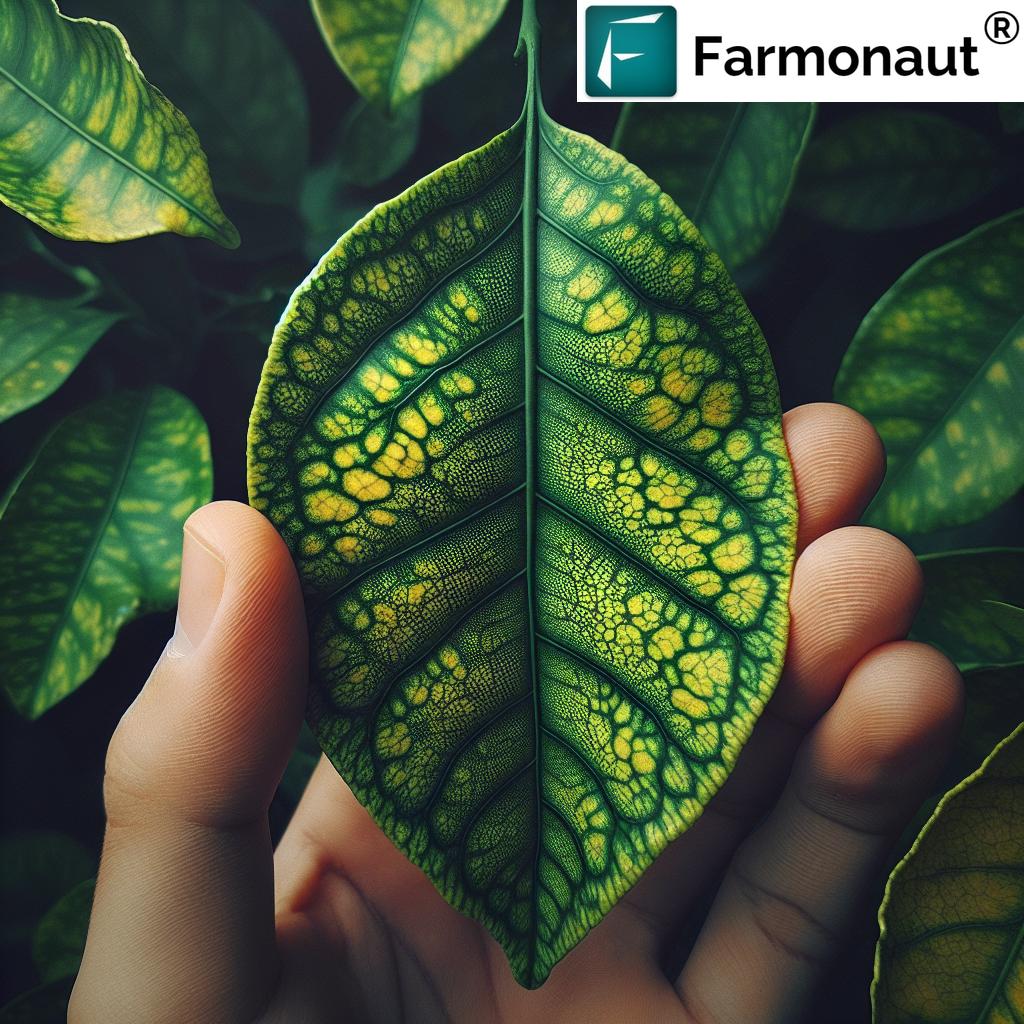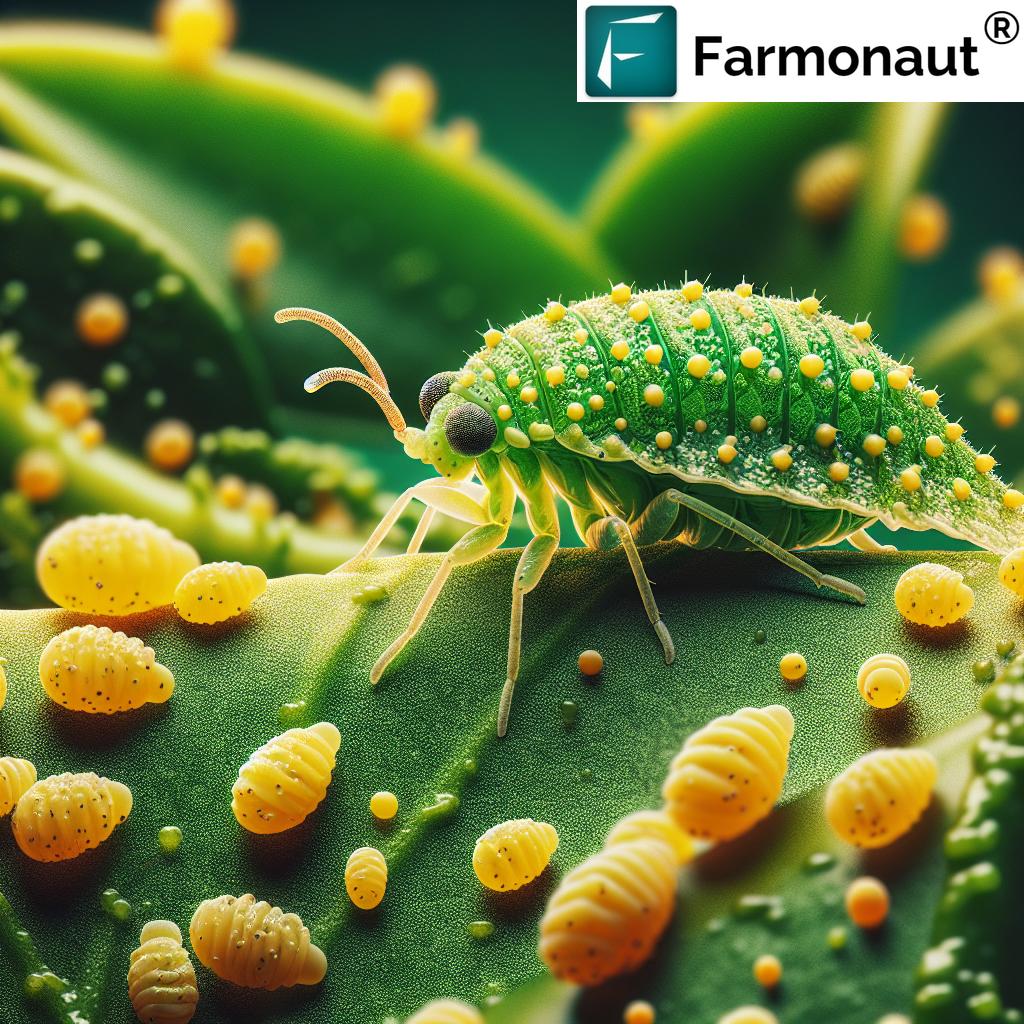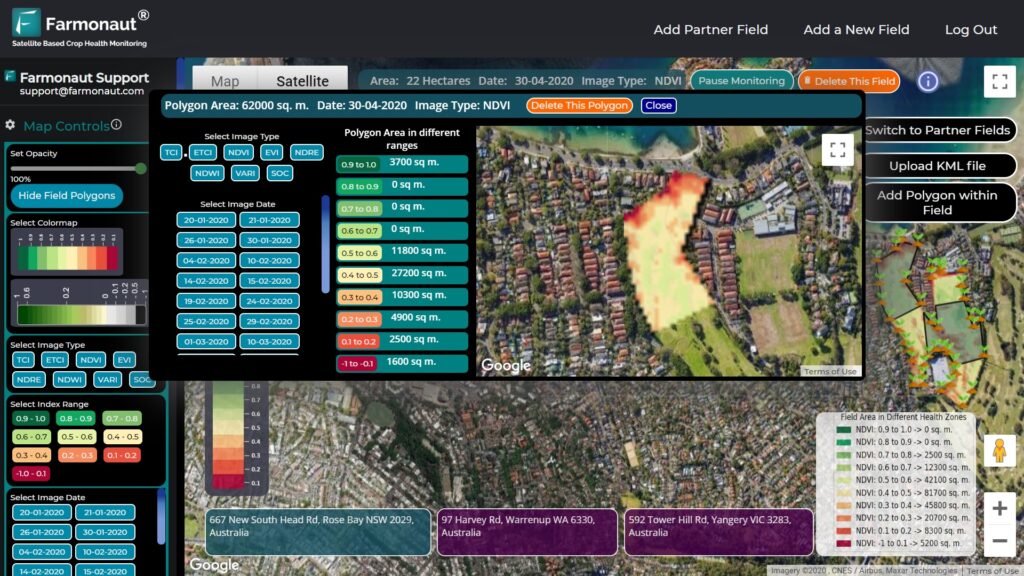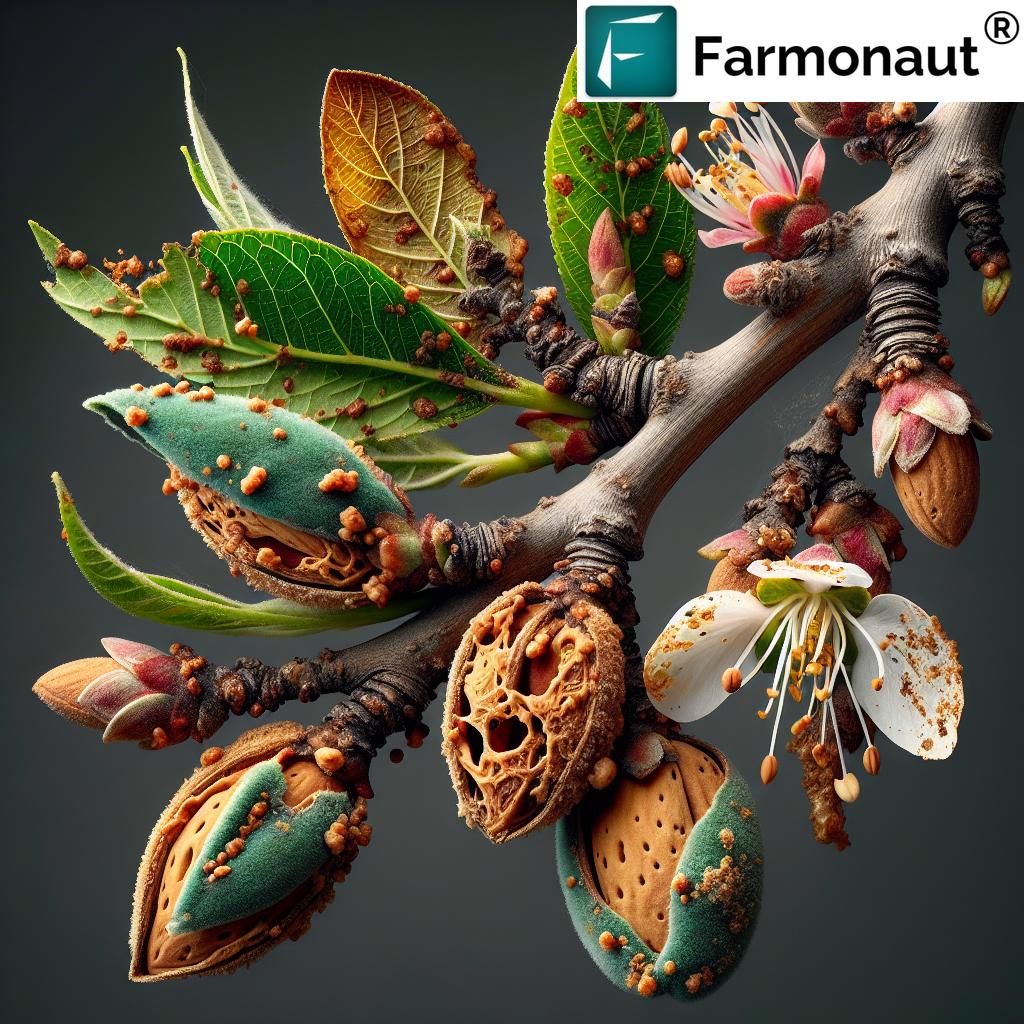
Citrus Greening Disease: A Comprehensive Guide to Symptoms, Stages, and Control Methods
In the world of citrus cultivation, few threats loom as large as citrus greening disease, also known as Huanglongbing (HLB). This devastating disease, caused by the bacterium Candidatus Liberibacter asiaticus, has been wreaking havoc on citrus orchards worldwide. At Farmonaut, we understand the critical importance of early detection and effective management of this disease. In this comprehensive guide, we’ll explore the symptoms, stages, and control methods for citrus greening, with a focus on both conventional and organic approaches.
Understanding Citrus Greening Disease
Citrus greening is a bacterial disease that affects all varieties of citrus trees. It’s primarily spread by a tiny insect called the Asian citrus psyllid (Diaphorina citri). This pest acts as a vector, transmitting the disease-causing bacteria from infected trees to healthy ones as it feeds on the leaves and stems of citrus plants.
The disease has had a devastating impact on citrus production in many parts of the world, including the United States, Brazil, and parts of Asia. It’s crucial for citrus growers to be well-informed about this disease to protect their orchards and livelihoods.
The Asian Citrus Psyllid: The Primary Vector
Before delving into the symptoms and stages of citrus greening, it’s essential to understand the insect responsible for its spread: the Asian citrus psyllid.
- Appearance: Adult psyllids are small, about 3-4 mm long, with mottled brown wings held roof-like over their bodies.
- Life Cycle: Females lay tiny, yellow-orange, almond-shaped eggs on new growth and leaf tips.
- Nymphs: The immature psyllids are yellowish-orange and produce waxy tubules that help in their identification.
- Feeding Habits: Both adults and nymphs feed on the sap of citrus leaves and stems, potentially transmitting the bacteria as they feed.
Understanding the psyllid’s behavior and life cycle is crucial for implementing effective control measures.
Symptoms of Citrus Greening Disease
Recognizing the symptoms of citrus greening is crucial for early detection and management. The disease affects various parts of the citrus tree, including leaves, fruits, and overall tree health.
Leaf Symptoms
- Blotchy Mottling: One of the most characteristic symptoms is blotchy mottling of leaves. This appears as irregular green and yellow patches on the leaf surface.
- Chlorosis: Leaves may show yellowing, particularly along the veins and midribs. This yellowing often appears asymmetrical on the leaf blade.
- Vein Corking: Veins may become thickened and appear cork-like, especially on the underside of leaves.
- Leaf Drop: Severely affected trees may experience premature leaf drop.
Fruit Symptoms
- Lopsided Fruits: Infected trees often produce fruits that are small, lopsided, or asymmetrical.
- Color Inversion: Fruits may show color inversion, where the bottom of the fruit remains green while the upper portion turns orange or yellow.
- Bitter Taste: The juice from affected fruits often has a bitter, medicinal flavor.
- Aborted Seeds: Seeds in infected fruits may be aborted or discolored.
Tree Symptoms
- Stunted Growth: Infected trees may show overall stunting and reduced growth.
- Twig Dieback: Branches may experience dieback, starting from the tips.
- Off-Season Flowering: Trees may bloom at unusual times of the year.
- Reduced Fruit Production: Overall fruit yield is significantly reduced in infected trees.
It’s important to note that these symptoms can be similar to those caused by other citrus diseases or nutrient deficiencies. Therefore, laboratory testing is often necessary for a definitive diagnosis.
Stages of Citrus Greening Disease
Citrus greening disease progresses through several stages, each with its own set of symptoms and challenges. Understanding these stages is crucial for effective management and control.
Stage 1: Early Infection
- Subtle leaf symptoms begin to appear, including slight yellowing or mottling.
- Trees may appear healthy overall, making detection challenging.
- Fruit production and quality may not yet be significantly affected.
Stage 2: Moderate Infection
- Leaf symptoms become more pronounced, with clear blotchy mottling and yellowing.
- Some branches may show signs of dieback.
- Fruit quality begins to decline, with some fruits showing lopsidedness or color inversion.
Stage 3: Severe Infection
- Widespread leaf symptoms across the tree, including severe chlorosis and leaf drop.
- Significant reduction in fruit production and quality.
- Extensive twig and branch dieback.
- Overall tree health declines rapidly.
Stage 4: Tree Decline
- Severe stunting and overall decline of the tree.
- Minimal fruit production, with most fruits being unmarketable.
- Extensive defoliation and branch death.
- At this stage, tree removal is often necessary to prevent further spread of the disease.
The progression of these stages can vary depending on factors such as tree age, citrus variety, and environmental conditions. Early detection and intervention are crucial for managing the disease effectively.
Conventional Control Methods
Controlling citrus greening disease requires a multi-faceted approach. Conventional methods often involve chemical interventions and strict orchard management practices.
Insecticide Applications
- Foliar Sprays: Regular applications of approved insecticides to control psyllid populations.
- Soil Drenches: Systemic insecticides applied to the soil can provide longer-term protection.
- Timing: Coordinating sprays with psyllid life cycles and flush periods for maximum effectiveness.
Tree Removal and Replacement
- Prompt removal of heavily infected trees to prevent them from serving as sources of inoculum.
- Replanting with disease-free, certified nursery stock.
- Considering the use of disease-tolerant citrus varieties where available.
Nutritional Support
- Enhanced fertilization programs to support tree health and potentially mitigate some disease symptoms.
- Foliar applications of micronutrients, particularly zinc and manganese.
Vector Management
- Monitoring psyllid populations through regular scouting and trap deployment.
- Coordinated area-wide management programs to reduce overall psyllid populations.
Organic Control Methods
For growers committed to organic production or seeking more environmentally friendly options, several organic control methods can be employed to manage citrus greening disease.
Biological Control
- Parasitic Wasps: Introduction of natural predators like Tamarixia radiata, which parasitize psyllid nymphs.
- Predatory Insects: Encouraging populations of ladybugs, lacewings, and other beneficial insects that feed on psyllids.
Organic Insecticides
- Neem Oil: Acts as a repellent and disrupts psyllid feeding and reproduction.
- Pyrethrin-Based Products: Derived from chrysanthemum flowers, these can effectively control adult psyllids.
- Horticultural Oils: Smother psyllid eggs and nymphs when applied correctly.
Cultural Practices
- Pruning: Regular pruning to remove infected branches and encourage new growth.
- Reflective Mulches: Can disorient psyllids and reduce their landing on trees.
- Trap Crops: Planting attractive host plants away from the main orchard to divert psyllids.
Plant Nutrition and Health
- Organic Fertilizers: Enhance overall tree health and potentially increase resistance to infection.
- Compost Teas: Boost soil and plant microbiome, potentially improving tree immunity.
The Role of Environmental Conditions
Environmental conditions play a significant role in the development and spread of citrus greening disease. Understanding these factors can help in developing more effective management strategies.
Temperature
- The bacterium thrives in warm temperatures, typically between 25-30°C (77-86°F).
- Cooler temperatures can slow disease progression but may not stop it entirely.
Humidity
- High humidity favors psyllid reproduction and survival.
- Dry conditions can stress trees, potentially making them more susceptible to infection.
Rainfall Patterns
- Heavy rains can wash off insecticide applications, reducing their effectiveness.
- Drought stress can weaken trees, making them more vulnerable to disease.
Seasonal Variations
- Psyllid populations tend to peak during spring and fall flush periods.
- Disease symptoms may be more pronounced during certain seasons.
By considering these environmental factors, growers can time their management practices more effectively and create less favorable conditions for disease development.
Innovative Detection Methods
At Farmonaut, we’re at the forefront of developing innovative detection methods for citrus greening disease. Our satellite-based monitoring system offers several advantages over traditional scouting methods.
| Aspect | Traditional Monitoring | Farmonaut Satellite Monitoring |
|---|---|---|
| Early Symptom Detection | Relies on visual inspection, may miss subtle early symptoms | Uses multispectral imaging to detect stress before visible symptoms appear |
| Large-Scale Orchard Monitoring | Time-consuming and labor-intensive for large areas | Can monitor vast orchards quickly and efficiently |
| Precision in Identifying Affected Trees | May overlook trees in early stages of infection | Provides precise location data for potentially infected trees |
| Cost-Effectiveness | Requires significant labor costs for regular scouting | Reduces need for frequent on-ground inspections, lowering overall costs |
Our satellite monitoring system can detect changes in tree health before visible symptoms appear, allowing for earlier intervention. This technology is particularly valuable for large-scale citrus operations where traditional scouting methods may be impractical or inefficient.
To learn more about how Farmonaut’s technology can help protect your citrus orchards, visit our application page or explore our API documentation.
Integrated Management Strategies
Effectively managing citrus greening disease requires an integrated approach that combines various control methods. Here are some key strategies:
1. Regular Monitoring and Early Detection
- Implement a rigorous scouting program to detect symptoms early.
- Utilize advanced technologies like Farmonaut’s satellite monitoring for large-scale detection.
- Train orchard workers to recognize early symptoms of the disease.
2. Vector Control
- Implement a comprehensive psyllid management program, combining chemical and biological control methods.
- Coordinate control efforts with neighboring growers for more effective area-wide management.
3. Tree Health Management
- Maintain optimal tree nutrition to enhance natural defenses against the disease.
- Implement proper irrigation practices to avoid water stress.
- Prune infected branches promptly to reduce inoculum sources.
4. Quarantine and Sanitation
- Enforce strict quarantine measures for new plant material entering the orchard.
- Implement thorough sanitation practices for tools and equipment used in the orchard.
5. Ongoing Research and Adaptation
- Stay informed about the latest research findings and control strategies.
- Be prepared to adapt management practices as new information becomes available.
By implementing these integrated strategies, citrus growers can significantly improve their chances of managing citrus greening disease effectively.
The Future of Citrus Greening Management
As we look to the future, several promising developments offer hope for more effective management of citrus greening disease:
Genetic Engineering
- Development of disease-resistant citrus varieties through genetic modification.
- Research into CRISPR gene-editing technology to enhance citrus tree immunity.
Advanced Biological Control
- Exploration of new natural enemies of the Asian citrus psyllid.
- Development of more effective biopesticides targeting the psyllid or the bacterium.
Nanotechnology
- Research into nanoparticle-based delivery systems for more effective treatments.
- Development of nanosensors for early detection of infected trees.
Artificial Intelligence and Machine Learning
- Advanced image recognition systems for automated symptom detection.
- Predictive models for disease spread based on environmental and biological factors.
At Farmonaut, we’re committed to staying at the forefront of these technological advancements. Our satellite monitoring system continues to evolve, incorporating the latest in AI and machine learning to provide even more accurate and timely information to citrus growers.
Conclusion
Citrus greening disease presents a significant challenge to the global citrus industry. However, with a comprehensive understanding of the disease, its vector, and the available control methods, growers can implement effective management strategies. The combination of traditional practices, innovative technologies, and ongoing research offers hope for the future of citrus production.
At Farmonaut, we’re dedicated to supporting citrus growers in their fight against this devastating disease. Our advanced satellite monitoring technology provides a powerful tool for early detection and management of citrus greening. By leveraging this technology alongside integrated pest management practices, growers can enhance their ability to protect their orchards and maintain productive citrus operations.
For more information on how Farmonaut can assist in managing citrus greening and other agricultural challenges, visit our website or download our mobile app:
Together, we can work towards a healthier, more resilient citrus industry.
FAQs about Citrus Greening Disease
- Q: Can citrus trees recover from greening disease?
A: Unfortunately, there is currently no cure for citrus greening disease. Once a tree is infected, it cannot fully recover. However, proper management can slow disease progression and maintain tree productivity for a longer period. - Q: How quickly does citrus greening spread?
A: The speed of spread can vary depending on factors such as psyllid populations, environmental conditions, and control measures in place. In severe cases, an entire orchard can become infected within a few years if left unmanaged. - Q: Are all citrus varieties equally susceptible to greening?
A: While all known citrus varieties are susceptible to some degree, some show more tolerance than others. For example, some mandarin varieties and certain citrus relatives like kumquats may show less severe symptoms. - Q: Can the disease spread through fruit consumption?
A: No, the disease cannot spread through fruit consumption. It is primarily spread by the Asian citrus psyllid or through the movement of infected plant material. - Q: How effective are organic control methods compared to conventional ones?
A: Organic control methods can be effective, especially when implemented as part of an integrated management strategy. However, they may require more frequent application and careful timing compared to some conventional methods. - Q: Can satellite monitoring completely replace ground-level scouting?
A: While satellite monitoring, like that offered by Farmonaut, is highly effective for large-scale detection, it’s best used in conjunction with ground-level scouting. The combination provides the most comprehensive approach to disease management. - Q: How often should citrus trees be inspected for greening symptoms?
A: Regular inspections are crucial. It’s recommended to inspect trees at least monthly, with more frequent checks during peak psyllid activity periods (usually spring and fall). - Q: Are there any human health risks associated with fruit from infected trees?
A: Fruits from infected trees are safe for human consumption, although they may have reduced quality and flavor. The bacterium that causes citrus greening does not affect humans. - Q: How can small-scale or home gardeners protect their citrus trees?
A: Home gardeners can protect their trees by regularly inspecting for symptoms, using appropriate insecticides or organic controls, maintaining tree health through proper nutrition and care, and removing any infected trees promptly. - Q: Is there ongoing research for a cure for citrus greening?
A: Yes, extensive research is ongoing worldwide to find more effective treatments and potentially a cure for citrus greening. This includes genetic research, new biological control agents, and advanced technological solutions.

For more detailed information on our satellite monitoring services and API documentation, visit our developer documentation page.
Ready to take your citrus orchard management to the next level? Subscribe to Farmonaut’s services:









